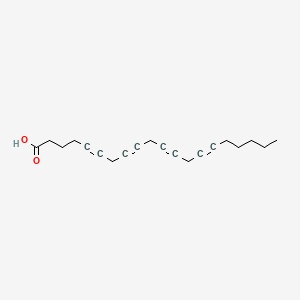|
|
|
|
pmid:15104243
|
| Zuo L et al. |
Lipoxygenase-dependent superoxide release in skeletal muscle. |
2004 |
J. Appl. Physiol. |
pmid:15107407
|
| Sánchez-Ferrer CF et al. |
Endothelial modulation of the ouabain-induced contraction in human placental vessels. |
1992 |
Circ. Res. |
pmid:1516165
|
| Sokolowski BH et al. |
Identification and localization of an arachidonic acid-sensitive potassium channel in the cochlea. |
2004 |
J. Neurosci. |
pmid:15254081
|
| Liu Q et al. |
NADPH oxidase produces reactive oxygen species and maintains survival of rat astrocytes. |
2005 Mar-Apr |
Cell Biochem. Funct. |
pmid:15386527
|
| Downie MM et al. |
Peroxisome proliferator-activated receptor and farnesoid X receptor ligands differentially regulate sebaceous differentiation in human sebaceous gland organ cultures in vitro. |
2004 |
Br. J. Dermatol. |
pmid:15491415
|
| Anderson KM et al. |
ETYA, a pleotropic membrane-active arachidonic acid analogue affects multiple signal transduction pathways in cultured transformed mammalian cells. |
1992 |
Clin. Biochem. |
pmid:1551235
|
| Li F and Malik KU |
Angiotensin II-induced Akt activation through the epidermal growth factor receptor in vascular smooth muscle cells is mediated by phospholipid metabolites derived by activation of phospholipase D. |
2005 |
J. Pharmacol. Exp. Ther. |
pmid:15525798
|
|
|
|
|
pmid:15556273
|
| Rousseau E et al. |
Capsazepine, a vanilloid antagonist, abolishes tonic responses induced by 20-HETE on guinea pig airway smooth muscle. |
2005 |
Am. J. Physiol. Lung Cell Mol. Physiol. |
pmid:15557084
|
